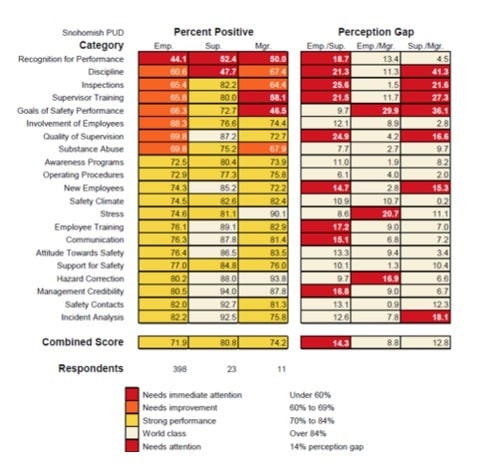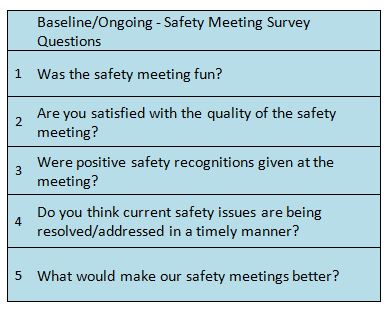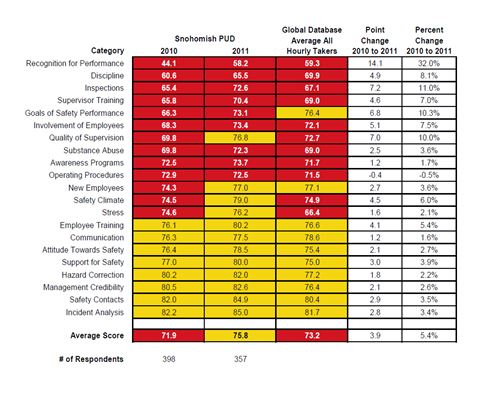Safety Case Study
Continuously Improve Safety Culture to Impact Bottom Line Results: A Case Study of Snohomish PUD
The continuous improvement process is a never-ending journey of employees getting actively involved in building the kind of safety system that they believe will work. Sonohomish PUD is moving from a culture of “us and them,” in which union employees and management were perpetually at odds, to a culture of working together as “us” toward a common goal of zero-incident performance.
Todd Efird, CSP
Why is it important to focus on safety culture improvement rather than safety programs? What’s the difference? There are many debatable definitions of culture. For the purposes of this article and case study, we will simplify it in this way: culture is the way people behave in their work environment when nobody is looking. Culture is based on the norms that are accepted as part of “the way we do things around here.” Let’s face it—most accidents happen when the safety person, or someone else from the management team, is not around. Managers and safety professionals cannot be everywhere, watching every employee’s behavior all the time. So what is the most effective approach to influencing your company’s culture?
Snohomish County
According to Snohomish County (Everett, WA) Public Utility Executive Chris Heimgartner, it’s about understanding the key components to a strong safety culture, then taking a strategic approach to improving these key areas. In 2009, Heimgartner began to evaluate the safety culture and corresponding safety results within the utility. He was dissatisfied with the rate by which employees were being injured and set on a path to implement a culture shift within the organization. He established a team of employees to begin a search for a consulting partner to assist in the journey. The team soon narrowed the search to two companies specializing in safety culture improvement and ultimately selected Caterpillar Safety Services (formerly Core Media) (Peoria, IL).
First Steps
The first step in the journey was to establish and train a Safety Steering Team, consisting of both management and bargaining unit employees, to make decisions about the right approach for the utility. The team was trained by Caterpillar Safety Services in the following two key culture improvement concepts and their role in the overall improvement process1:
6 Criteria for Excellence
-
Senior management VISIBLY committed
-
Middle management ACTIVELY involved
-
Supervisors focused on QUALITY activities
-
Employees ACTIVELY involved
-
Flexibility to meet site culture
-
Positive perception among employees
4 Accountability Steps
-
Clearly defined activities
-
Training at all levels
-
Measurement systems
-
Recognition for performance
Safety Perception Survey
Next, the team decided to conduct a Safety Perception Survey (SPS) to identify strengths and weaknesses in the organization’s safety culture, and to identify any gaps in perceptions between employees, supervisors, and managers (Figure 1).The SPS takes the guesswork out of safety culture assessment. Developed by safety guru, Dr. Dan Petersen and tested over a 20-year period, the survey is the only statistically validated measurement tool on the market. The 99 yes-no questions included in the survey map back to 21 key safety culture categories, which are scored by a percent-positive response. Every individual in the organization, from the CEO to the hourly employees, is administered the same survey questions. The responses are categorized by job function into three groups—hourly employees, supervisors, managers—in order to reveal perception gaps between those groups that could be hampering strong performance.The SPS can be administered and scored within a six to eight week period, after which the survey results can be used by a steering committee to provide direction to a continuous improvement team (CI Team).
Continuous Improvement Teams
The Snohomish team developed a communication plan for sharing the results with employees and a strategic plan to use the data for continuous improvement efforts. The survey results revealed the lowest scoring category was recognition for performance. In other words, employees believed attention to safety issues was almost always focused on the negative, rather than on noticing and recognizing positive action. Based on this feedback, the steering committee asked CI Teams, comprised of employee volunteers at the hourly and supervisor levels, to develop strategies for incorporating positive recognition into the Snohomish culture. Ideally, each CI Team should focus on one, manageable area of an organization’s day-to-day activities in which improved protocol could enhance overall safety culture.
One CI Team designated safety meetings as an area for improvement that would touch on several key factors influencing safety culture, including recognition. The group spent about one week identifying existing barriers to safety excellence and developing solutions for improvement. Their purpose, outlined on day one, was to create a more productive safety meeting process by defining roles, encouraging active participation and promoting a positive and safe work environment. Ultimately, their chosen processes met the six criteria for excellence and four steps to accountability. In every organization pursuing safety culture excellence, employee ownership of the drive for continuous improvement starts with the continuous improvement team, then permeates the organization through the successful execution of a its plan.
Pilot Project
Once its plan was set, the CI Team selected groups within the organization to pilot the new ideas. The key to success at this juncture of the process was choosing pilot groups that would embrace the opportunity for improvement and see rapid success from its efforts. Pilot groups were designated in three areas of the utility: transportation, meter and electrical line crews. The process began with the CI Team surveying the pilot groups about the current safety meeting procedures and outcomes, which provided a baseline for improvement (see Figure 2).
The CI Team then trained the pilot members to implement strategies for improvement. Regular communication between the CI and pilot teams provided the key measurement of the pilot’s success. Regular survey results and simple dialog between employees about which components of the plan were working, and which areas needed modification, helped the CI Team craft a stronger strategy for implementation utility-wide. After the necessary modifications were made, the plan was rolled out to the entire organization by the employees who built it—the essence of active employee involvement in building and owning new safety processes.
About two years after completing its first Safety Perception Survey and running three CI Teams, Snohomish followed up with another round of the SPS. The results demonstrated marked improvement, particularly in the area of recognition, where a 32 percent increase in positive responses was recorded (see Figure 3).
The Results
The continuous improvement process is a never-ending journey of employees getting actively involved in building the kind of safety system that they believe will work. Sonohomish PUD is moving from a culture of “us and them,” in which union employees and management were perpetually at odds, to a culture of working together as “us” toward a common goal of zero-incident performance.
Todd Efird is a Certified Safety Professional with more than 22 years of safety management experience. As a Senior Safety Consultant with Caterpillar Safety Services, Todd leverages his expertise in leadership and accountability training to help organizations in a variety of industries achieve zero-incident performance. For more information about other utility companies, construction companies, underground mining, health care, and heavy manufacturing companies who have embarked on this culture improvement journey, contact Caterpillar Safety Services at [email protected].
Note
-
The 6 Criteria for Excellence and the 4 Steps to Accountability were outlined by Dr. Dan Petersen. Petersen, Dan. “Human Error Reduction and Safety Management”, Third edition, copyright 1996, Van Nostrand Reinhold.
Figure 1
The Safety Perception Survey establishes a baseline measurement of employee attitudes and perceptions across 20 statistically validated safety culture indicators. Large perceptions gaps between employee groups indicate the need for culture improvement.
Figure 1 courtesy Caterpillar Safety Services.
Figure 2
The C.I.Team created a simple survey to establish a baseline for safety meeting improvement. Ongoing surveys revealed employee satisfaction with safety meetings improved as C.I. Team initiatives were implemented.
Figure courtesy Snohomish County Public Utility District.
Figure 3
Snohomish took a second Safety Perception Survey about two years after its initial assessment. Results showed a marked improvement in the area of positive recognition.
Figure 3 courtesy Caterpillar Safety Services.



